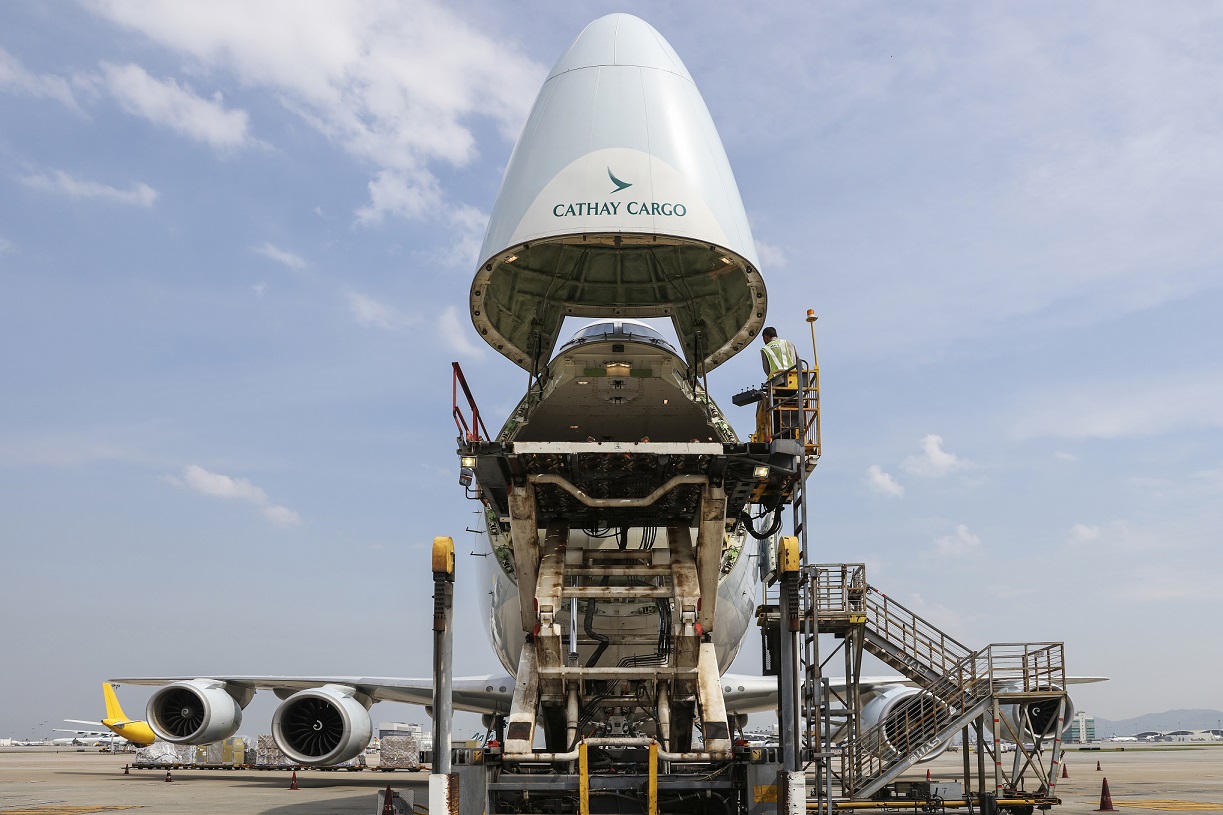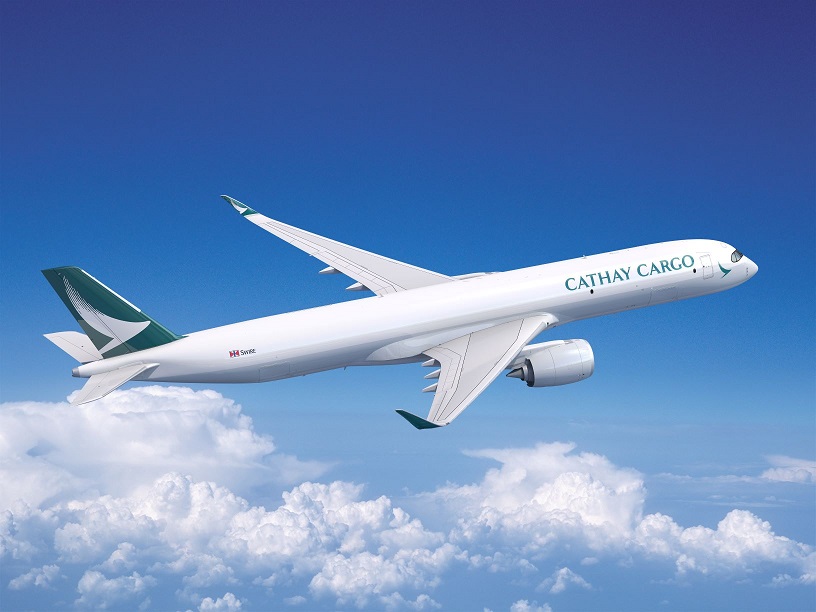Cathay sets its sights on 2024 air cargo demand
02 / 02 / 2024

Chris Bowden. Source: Cathay Cargo
Cathay Cargo is gaining altitude post-pandemic and is optimistic for demand in 2024, explains Chris Bowden, head of cargo global partnerships at Cathay Pacific.
2023 was a year that saw Cathay and its cargo division Cathay Cargo begin to build up volumes and capacity, plus announce a major freighter order.
From 2020 to 2022, Cathay was shackled by pandemic containment measures, but 2023 was a year of recovery.
“We’ve recovered pretty quickly from a difficult base,” says Chris Bowden, head of cargo global partnerships at Cathay, speaking to Air Cargo News in November.
Bowden experienced a baptism of fire when in February 2022 he took on his present role managing the global partnerships and marketing teams of Cathay Cargo and witnessed the rapidly changing challenges the cargo team faced.
He began his career with Cathay in August 2018 as a country manager for Indonesia before moving to Hong Kong with his family in September 2020 when he was appointed head of planning and business improvement focusing on efficiency and customer care.
What followed was another year of acute uncertainty for the business. Economic conditions toughened, inflation rose, and volumes decreased, while air cargo rates dropped and there was a shift back to seafreight.
Cathay, of course, faced extra challenges. While belly capacity started returning to the market for many airlines in 2022, Cathay’s passenger flights, which account for 50% of its capacity, continued to be impacted by government quarantine restrictions in the first half of the year.
The restrictions in the first half of 2022 also put the breaks on the airline’s long-haul freighter operations.
The pandemic rules were relaxed in the second half of 2022, which saw the airline build back flights, particularly in the last quarter. Meanwhile, full freighter operations resumed in June.
“The restrictions and the knock-on effect that (the pandemic) has had on the passenger business means that the capacity in the passenger bellies has come back a lot slower,” Bowden says.
Peak perks
Then in 2023, with restrictions lifted and borders in the Chinese Mainland reopened, Cathay rebuilt its network and volumes increased.
Overall, in the first 11 months of 2023, tonnage increased by 19.5% compared with the same period for 2022.
In the second half of the year exports, particularly e-commerce and consumer goods, helped boost volumes from September.
Cathay Cargo has also seen a fourth-quarter peak, greatly helped by e-commerce business.

Source: Cathay Cargo
“The big consumer markets are all impacted by the e-commerce trend,” Bowden points out. These markets include North America, Europe, Singapore, and Australia.
“We’ve been well impacted by the e-commerce boom, which has come on a lot quicker and bigger than we expected and that’s flowing through to the end of the year. We’re seeing quite a strong finish,” he says.
The e-commerce boom is supported by production in southern China and consumption in North America in particular.
“This plays very well into Cathay’s geographical positioning with Hong Kong as the world’s largest airfreight hub,” Bowden points out.
But 2023 wasn’t without issues. Revenues declined due to the weak market, which also saw rates decline. Nonetheless, increased capacity specifically within Cathay is a positive for the company.
“By the end of 2024 we’re targeting for our cargo capacity to be back to what it was pre-Covid,” says Bowden.
And Cathay Cargo does expect sustained demand in 2024.
“We’re seeing lots of opportunities, including transpacific and intra-Asia,” he explains.
Cathay believes that demand for e-commerce will persist throughout 2024, and that this, coupled with demand for traditional cargo means “2024 demand will be an increase on 2023”, says Bowden.
He adds: “[For 2024], generally, we’re confident. The comparison point is with pre-Covid. And compared to 2019, we see 2024 as a better year.”
What and where’s driving business?
It’s not just e-commerce that’s driving growth. Cathay Cargo’s pharma, fresh food, mail products and specialist outsize shipments are also important, says Bowden.
For example, fresh produce from South America into Hong Kong and the Chinese Mainland is a big growth area.
Interline partnerships mean that South America is an important market for Cathay.
“The market data on South America suggests that we are the biggest importer from South America into Hong Kong. But we don’t actually fly there.” says Bowden.
A physical limitation on networks is the capabilities of freighters, meaning expansion through partnerships can fill the gap.
Bowden, who studied Swahili and Development Studies at university and spent time living in Africa earlier in his career, also identifies the continent as having development opportunities for Cathay.
“There is a gap in our network map. We fly to Johannesburg, and we have some partnerships that let us access Africa, but it’s underdeveloped compared to the rest of the world.
“The company’s focus remains on the gigantic opportunities of Hong Kong and the wider Greater Bay Area, but from a personal perspective over the next 20 years Africa offers great new potential. I can see it becoming increasingly important.”
A350Fs to meet demand
To help meet future demand, Cathay Cargo has ordered six Airbus A350 freighters, with the right to order 20 more.
The deal, worth around $2.7bn, will see deliveries of the freighters from 2027 until 2029.
This is a change in direction for the company, which, until the order was announced in December, had an all-Boeing cargo fleet – including six owned 747-400ERFs, and 14 747-8Fs.
“We’re coming from a homogenous fleet of 747s, which has been the bread and butter of the cargo industry for so long,” says Bowden. “That’s what we know and the base that we work from. That said, we fly A350 passenger aircraft, so understand what these new freighter aircraft offer us and we are excited to welcome them to the fleet.”

© Airbus S.A.S. 2023
Bowden describes a cautious but not hesitant approach to aircraft investments.
“We are happy to explore the market and see what’s there. We look at opportunities on merit as they become available.
“The business case for investment in fleets is a long-term perspective but if other opportunities were available, we’d explore them.”
Challenges ahead
If the last three years have demonstrated anything it’s that challenges should always be expected.
One such example was the market shift from airfreight back to seafreight post-pandemic, but this is accepted by Cathay Cargo as part of the ebb and flow of multimodal logistics.
Reflecting on previous market speculation that maritime players moving into airfreight during the market high could take market share from air cargo business, Bowden concludes the movement hasn’t impacted air cargo business in the way expected.
“I think what (the transition of maritime companies into airfreight) demonstrates is these sectors are not necessarily in full competition but that they can complement each other.
“While it definitely has an impact on capacity and tonnage, the market dynamic of consumers wanting products quickly means that airfreight is constantly in demand. It’s just about how the pie is shared.”
Bowden is personally well versed with multimodal logistics. He joined Cathay shareholder the Swire Group 15 years ago and worked across a variety of offshore oil and gas shipping roles for Swire Pacific Offshore for nearly 10 years, latterly as general manager for Southeast Asia, based in Singapore.
The switch to aviation was attractive for its speed and complexity.
“When you look at what we did in the maritime sector there were 25 ships hired out to individual clients some of them on 10-year deals. Whilst operationally extremely complex, commercially, the pace of the offshore shipping industry is slower than aviation.
“An aircraft will fly multiple rotations a week with 1,000s of clients. It’s a really different corporate relationship, contracting space and commercial space that moves so much quicker, which makes it incredibly exciting.”
The geographical diversification of production as with the development of the China Plus One strategy is also a challenge, but not a threat, says Bowden.
“The network of Cathay is so well set up that whether a company produces in India, southern China or Indonesia it’s still got to send its product to the US, and to get there it’s got to go through somewhere and there’s nowhere that’s better positioned than Hong Kong.”
Perhaps the biggest challenge for Cathay is sustainability, says Bowden.
Along with the rest of the industry, Cathay is chasing net zero emissions by 2050. By 2030, the company is aiming for SAF to make up 10% of its fuel usage.
To address SAF availability issues, Cathay has signed a Memorandum of Understanding with State Power Investment Corporation — one of the largest state-owned energy companies in the Chinese mainland and a company with the world’s largest solar power installed capacity — to facilitate the establishment of four SAF plants in the Chinese Mainland.
The airline also launched a corporate SAF programme last year which offers customers the chance to contribute to the use of SAF.
In efforts to cultivate increased collaboration with important stakeholders, Cathay recently welcomed new partners into its Corporate SAF Programme, two of which are cargo customers.
Elsewhere it has significantly reduced single-use plastics on passenger flights and has upped recycling of materials. It is also going paperless by digitising processes and is introducing electric ground vehicles.
Additionally, the airline has a ‘Fly Greener’ carbon offsetting scheme, which was launched recently in the cargo business.
SAF is the golden child in the family of sustainability, while carbon offsetting is overlooked, says Bowden, “because it doesn’t solve the problem at the source, but it remains an option while we’re building up to more availability of SAF”.
Green fuels and technology aside, getting all stakeholders within the supply chain onboard with sustainability is harder within cargo than passenger, explains Bowden.
“The cargo world is very competitive, and any increase in rate that isn’t fully understood through the supply chain makes it hard to get the buy-in.
“On the passenger side, there’s a greater propensity to spend on sustainability. Whereas if you’re looking at a traditional cargo business relationship, then we’re selling sustainability to a forwarder, who’s selling it to a shipper, who’s trying to understand how it affects the consumer. It’s a much more convoluted chain.”
But he adds: “The most exciting part of what I do day to day is probably with the sustainability teams. Because we don’t yet necessarily know exactly what the route is to get to net zero by 2050.
“You’re considering new technology, you’re looking for partners, you’re trying to find supply chains where you haven’t looked before. And that’s quite innovative and inspiring.”
Another focus area for Bowden within the Group has been championing gender equality. He currently co-chairs the gender equity network for Cathay.
“We’re trying to make sure that gender equality is embedded within the culture of the business,” he says. “There’s still work to be done but aviation is pretty far ahead of a lot of other industries.”
Incidentally, for Bowden, culture is a major part of the appeal of Cathay.
“My long-term goal is to stay with the Cathay Group and see its recovery really transform the company,” he says.
He remains enthusiastic about future business opportunities: “Cargo’s genuinely entrepreneurial. I don’t know where else in the aviation sector you can wake up, go out, talk to almost any business and try to build a deal from that.”
Cathay Cargo volumes continue recovery in 2023 but still lag 2019 levels














